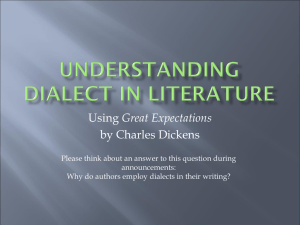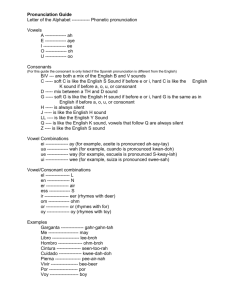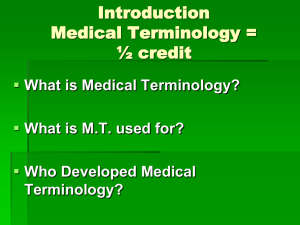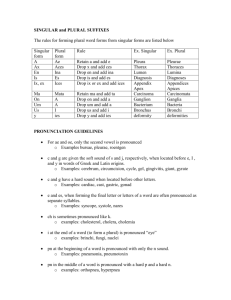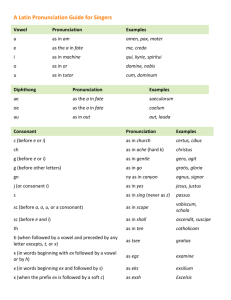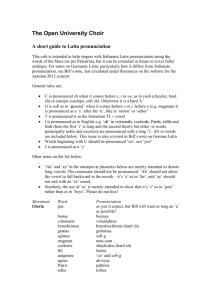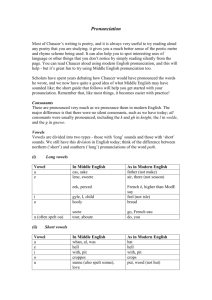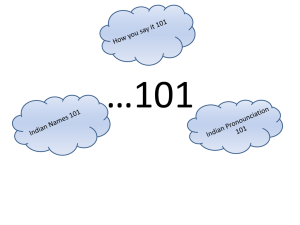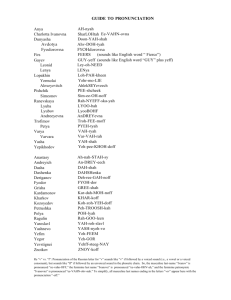An Introduction to Middle English
advertisement
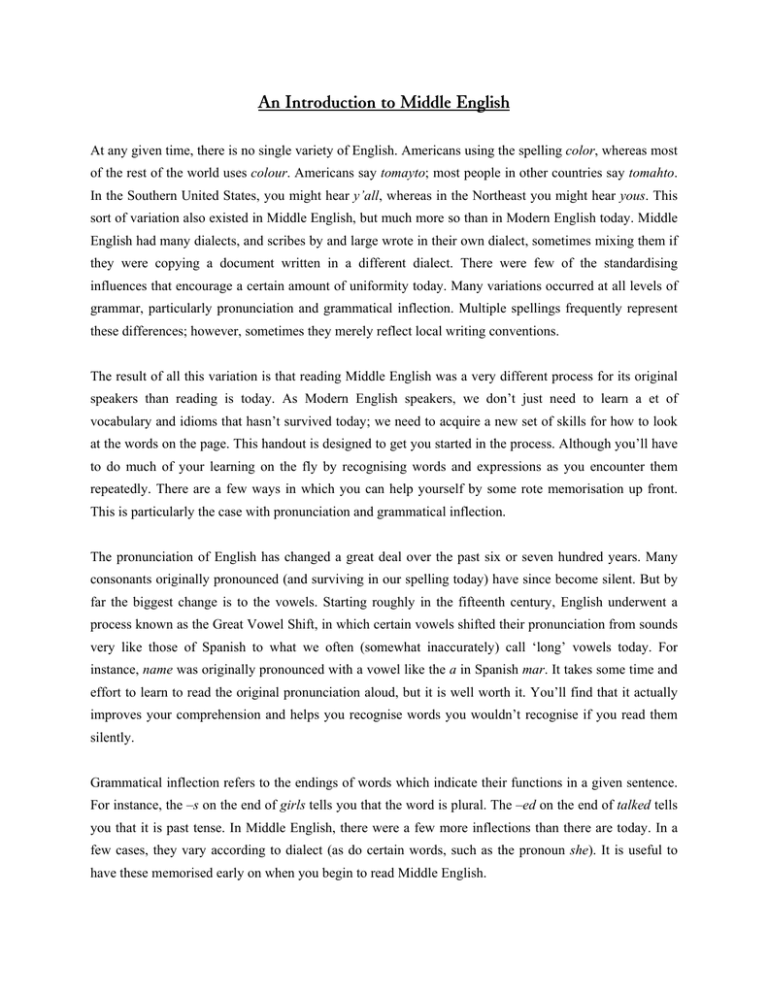
An Introduction to Middle English At any given time, there is no single variety of English. Americans using the spelling color, whereas most of the rest of the world uses colour. Americans say tomayto; most people in other countries say tomahto. In the Southern United States, you might hear y’all, whereas in the Northeast you might hear yous. This sort of variation also existed in Middle English, but much more so than in Modern English today. Middle English had many dialects, and scribes by and large wrote in their own dialect, sometimes mixing them if they were copying a document written in a different dialect. There were few of the standardising influences that encourage a certain amount of uniformity today. Many variations occurred at all levels of grammar, particularly pronunciation and grammatical inflection. Multiple spellings frequently represent these differences; however, sometimes they merely reflect local writing conventions. The result of all this variation is that reading Middle English was a very different process for its original speakers than reading is today. As Modern English speakers, we don’t just need to learn a et of vocabulary and idioms that hasn’t survived today; we need to acquire a new set of skills for how to look at the words on the page. This handout is designed to get you started in the process. Although you’ll have to do much of your learning on the fly by recognising words and expressions as you encounter them repeatedly. There are a few ways in which you can help yourself by some rote memorisation up front. This is particularly the case with pronunciation and grammatical inflection. The pronunciation of English has changed a great deal over the past six or seven hundred years. Many consonants originally pronounced (and surviving in our spelling today) have since become silent. But by far the biggest change is to the vowels. Starting roughly in the fifteenth century, English underwent a process known as the Great Vowel Shift, in which certain vowels shifted their pronunciation from sounds very like those of Spanish to what we often (somewhat inaccurately) call ‘long’ vowels today. For instance, name was originally pronounced with a vowel like the a in Spanish mar. It takes some time and effort to learn to read the original pronunciation aloud, but it is well worth it. You’ll find that it actually improves your comprehension and helps you recognise words you wouldn’t recognise if you read them silently. Grammatical inflection refers to the endings of words which indicate their functions in a given sentence. For instance, the –s on the end of girls tells you that the word is plural. The –ed on the end of talked tells you that it is past tense. In Middle English, there were a few more inflections than there are today. In a few cases, they vary according to dialect (as do certain words, such as the pronoun she). It is useful to have these memorised early on when you begin to read Middle English. Spelling and Pronunciation Because Middle English spelling is so variable, and because pronunciation varied in different dialects, the rules below must be taken as rough guidelines. You will have to study each individual text to recognise its peculiarities. Vowels a only as in father, never as in at or in name: alle, tale, maken. e followed by one consonant and another syllaable, pronounced like in hey, but more clipped: here, yede, swere. e with two consonants following, pronounced as in bet: herkneth. e in unstressed syllables, particularly at the ends of words, pronounced as in horses: gode, here, yede. i, y pronounced like in machine: wives, rym, knict, ivele, yvel. o pronounced as in note, never as in hot (American pronunciation): gode, do(n), holden, holy, more. o where the modern pronunciation of the word is like young is pronounced in Middle English like the sound in boot: lovede, comen. ou, ow pronounced like the sound in boot: young, brouth, mouthe, browt, nouth. u pronounced like the sound in boot: but, yung, cuppe, ful. au, aw pronounced like the sound in house: cause, law. ay, ai, ey, ei pronounced like the sound in kite: sayle, day, wey, heir. oi, oy pronounced like the sound in boy: coy. Notes: (1) Unstressed e is often not pronounced at the end of verse lines or if the following word begins with a vowel or h. So in of a tale that ich you wile telle the final –e of tale, wile, are pronounced, but not that of telle. (2) Final –e, whether pronounced or not in Middle English, can indicate a ‘long’ vowel in Modern English: gode, yhere, bord, micte. In such instances, the long vowel may be spelt with two vowels in Modern English: good, hear, board. Consonants h pronounced as in heaven, but often silent, as in hevere, holde. k pronounced in words like knight, know. w pronounced in words like writen. wh, w, hw, qu may be pronounced as hwor w: wo, whil, hwan, quanne. l pronounced in words like half, folk. gn pronounced as ny: signe (as in French signer). ch pronounced like the sound in Scots loch, German Bach: knicht (cht often appears as ct, cth, or th). s never pronounced like z at the end of a word: wives. i occasionally used for the j sound. u occasionally used for the w and v sounds. Notes: (1) Middle English possessed two letter forms not in Modern English: þ (thorn) and ȝ (yogh). The thorn is pronounced like ‘th’ (either in the or in thick). As time went on the ‘th’ spelling also came into use, and you might see the two alongside each other. Some editors of modern editions of Middle English texts (especially Chaucer’s works) have changed all the thorns to ‘th’. The pronunciation yogh varied according to its position in the word. In the vicinity of the vowels i and e (except before t), it was pronounced like the consonant y (e.g. ȝe = ye). Elsewhere it was pronounced like the ch in Scots loch, German Bach, except with more vibration of the vocal cords. Words which had yogh in this position generally have gh in their spelling today (e.g. niȝt = night). Grammatical Inflections Note: This is not a comprehensive account of Middle English grammar. The points here are merely to call to your attention certain features of Middle English which should help you gain a reading knowledge of the language. Nouns 1. The plural of most nouns is –es or -s. Some nouns have plurals with –(e)n: brethren, children, (e)yen ‘eyes’, oxen. Some words may appear with either ending. 2. The possessive forms end in –es or –s (with no apostrophe). Verbs 1. The basic, or infinitive, form of the verb originally ended in –en or –n: riden ‘ride’, drinken ‘drink’ 2. The present tense is indicated by endings as demonstrated in the following examples: I wil(e); thu knowest; he yeveth; we wolden; ye knowen; he knowen. 3. In the past tense there are two types of verbs: strong and weak. Strong verbs correspond to Modern English verbs like ‘sing, sang’, which form their past tense with a change in the vowel. Weak verbs in Modern English form their past tense like ‘talk, talked’. a. In Middle English, strong verbs were more numerous today. For instance, ‘help’ was a strong verb; its past tense was holp. The past forms of strong verbs are as follows: I sang, thou songe, he/she/it sang, we/ye/they songen. b. Past participles (Modern English taken, eaten, etc.) of strong verbs take a variety of forms. Originally they ended in –en, bur sometimes the –n is dropped: dronke, dronken. The past participle also often had a prefix: i-/y-: y-dronke, y-dronke. c. The past tense of weak verbs was formed with –d(e)/-ed or –t(e). The endings were as follows: I herde, thou herdest, he/she/it herde, we/ye/they herden. The past participle ended in –ed and could have the prefix i-/y-: maked, imaked. d. Imperatives, or commands, have the endings –e in the singular and –eth in the plural: herkneth. Pronouns 1. The pronoun I often appears in its older form ich. 2. Middle English has singular and plural words for ‘you’, rather like the distinction between ‘you’ and ‘y’all’ (in the southeastern United States) or ‘yous’ (in Ireland, western Scotland, New York, and Boston). The singular form is thu, thou. The plural form is ye for the subject of a sentence; otherwise it is you. Ye was also used in the singular to imply formality, or sometimes intimacy. 3. The word thee (used for direct objects, objects of prepositions, etc.) is frequently spelt with one e and can thus easily be confused with the word for ‘the’. 4. Thou is often contracted with verbs: artow = art thou ‘are you’, wiltou = wilt thou ‘will you’. 5. The word for ‘she’ had many different forms in Middle English (depending on the dialect), many similar to he, heo, and hi. Hence they can be easily confused with the words for ‘he’ (he) and ‘they (hi)’. Sometimes the only way you can tell who is being referred to is to go by context. 6. The same goes for the possessive and object forms of these words: him (‘him’), hire (‘her’), hem (‘them’); his (‘his’), hire (‘her’), hire (‘their’). 7. The word for ‘it’ was hit. The possessive form was his.
